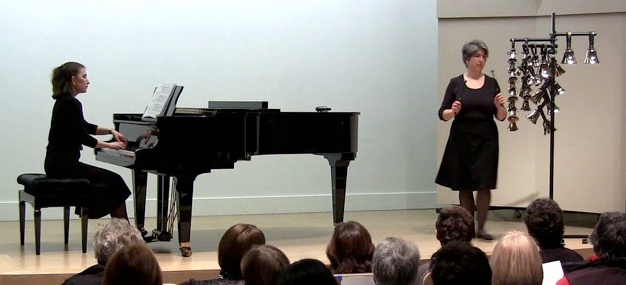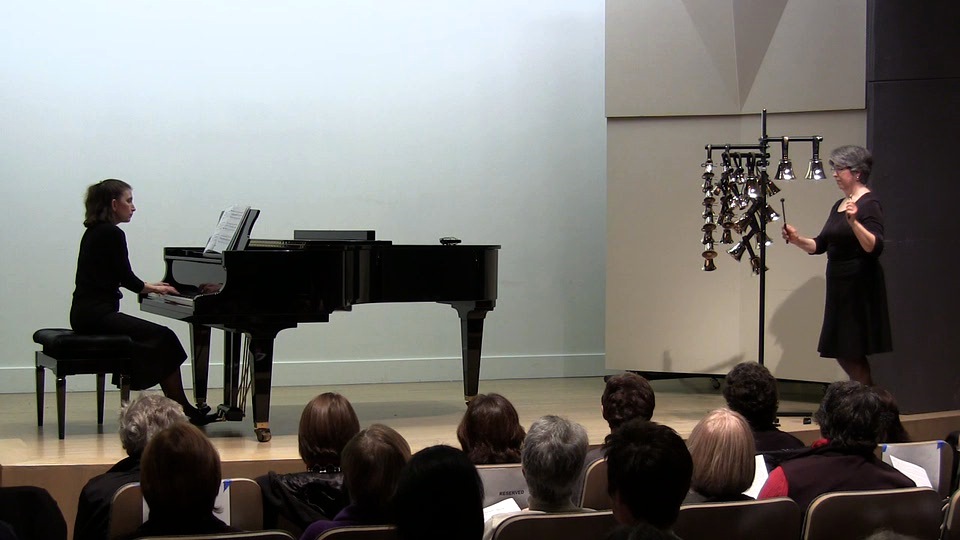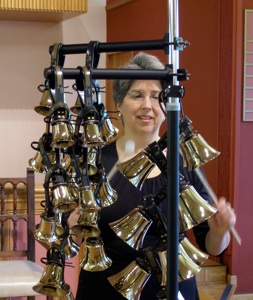I was flattered when someone complimented my musicality on a recent bell tree video of Linda Lamb’s gorgeous Celtic Farewell. That started me thinking about the elements of musicality in bell trees, and some ideas that have helped me move toward a more musical performance. Some of these elements also apply to bells played from the table. Continue reading Bell trees: musicality
Category Archives: Bell trees
Bell trees: tips and tricks
As I continue researching articles on equipment, I’d like to share various tips I’ve learned in recent months of working with bell trees. I’m preparing for a group concert at a museum to celebrate the opening of a Russian art exhibit. Due to space constraints and the need to play a non-seasonal work by a Russian composer (Nutcracker would be frowned on in February), I decided to adapt Nancy Hascall’s arrangement of Orientale for bell trees. Continue reading Bell trees: tips and tricks
Mallet technique: basics
See the article on Mallets for information on buying mallets and matching them to bells.
I strongly recommend scheduling some sessions with a professional percussionist to learn proper mallet technique. Ask around for a marimba instructor: call music stores that sell percussion instruments, contact the local music schools, and ask your musician friends for recommendations. There’s no substitute for hands-on instruction by a pro. Try to have someone come to where your bells are so you can work with your equipment, both trees and table bells. Second best would be to take your bell trees to your instructor’s studio. If neither will work, you can learn a lot using the instructor’s mallets and marimba, but you’ll be on your own transferring that knowledge to bells. Continue reading Mallet technique: basics
Bell trees: composing and arranging
Today’s article will address both composing for bell trees (for trained composers) and creating your own arrangements (for bell tree soloists).
It will help to become familiar with the bell tree keyboard configuration, and choose a layout you intend the soloist to use, either the one I’ve described or the one developed by Barbara Brocker. Regardless of your intent, handbell soloists may develop their own setup for your piece, but you have to start somewhere. Continue reading Bell trees: composing and arranging
Mallets
Mallets are an external clapper mechanism. They can be used to create either a stopped sound (malleting bells on the table) or a sustained sound (malleting bells in the air, either singly or in bell trees). The object is to produce the same timbre as the clapper would. Bell manufacturers provide a variety of mallets intended for particular ranges of bells. In general, the bigger the bell, the bigger and softer the mallet. The mallets may be covered with yarn or other soft material. Smaller bells call for smaller, harder mallets, often made of rubber or plastic. Continue reading Mallets
Bell trees: equipment
The standard range for bell tree pieces using current methods is G4-G7. It’s possible to play with a much smaller range, and you could start with C5-C7 or even fewer bells. For example, the popular ‘Symphonia on Hyfrydol’ uses only C6-D7 (with F7, which could be left out) in the solo version of the bell tree part. Continue reading Bell trees: equipment
Bell trees: basics
Bell trees were discovered by Louise Frier in the 1980s. As she tells the story, she was working with mallets and also noticed handbell musicians carrying bells from their cases to the bell table by “treeing them up” (looping the handles through others to create a strand, like crocheting, or braiding a sailboat line). In one of those Aha! moments that herald innovation, she put the two ideas together and began malleting bells in trees. Over time, repertoire developed, not only bell tree parts in choir pieces, but works entirely for bell tree soloists. Continue reading Bell trees: basics
Recording: ‘Symphonia on Hyfrydol’ on bell trees
While I continue working on the next choreography article, I wanted to share this with you. It’s the bell tree section of the popular ‘Symphonia on Hyfrydol’ by Kevin McChesney, recorded as the postlude Sunday, October 30, 2011 at St. Stephen’s Episcopal Church in Seattle. Continue reading Recording: ‘Symphonia on Hyfrydol’ on bell trees
Hearing protection
Hearing is a musician’s most important asset. As handbell musicians, and especially as soloists, we routinely put a loud, high-pitched instrument near our ears. We may rehearse in a room that reflects sound back at us, or in a row in front of other handbell musicians. We need to think early in our musical journey about protecting our hearing. It’s particularly important for advanced ringers, who may be exposed to more four-in-hand techniques in the high treble, and for those ringing bell trees. Bells on bell trees aren’t generally damped, so there’s an accumulation of sound right at ear level. Church ringers may need to think about protecting their hearing at Easter, where brass instruments may be combined with the bell choir, perhaps playing behind them. Continue reading Hearing protection



